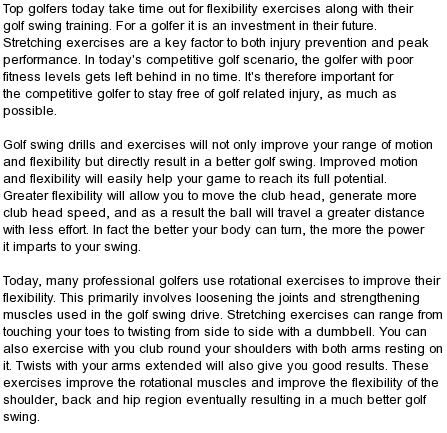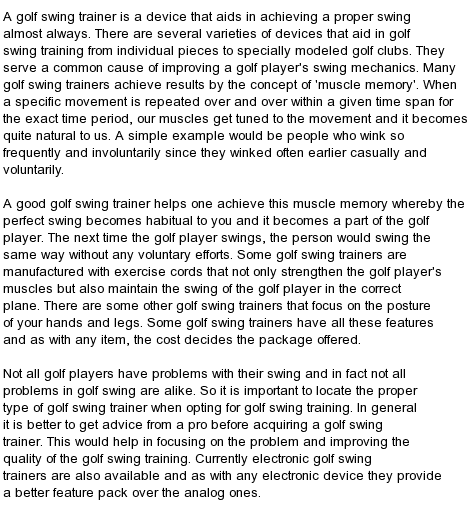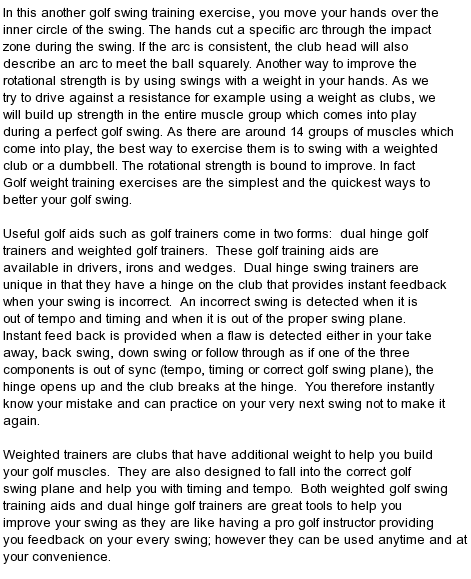UnSwing Training Club Features
UnSwing Training Club Features
Revolutionary New Off-handed association (lefty clubface for righty golfer)
Creates new sense of balance on both edges of the swing – broader sway arc makes optimum correctness and expanse.
Forces new awareness/connection with the brain and body that encourages concentration, calmness, and better tempo – golfer is now snug with the painful.
Molded, divide Hand Grip
conceives correct spine angle/tilt at address and through impact/finish
Enhances seem of correct hand positions throughout the swing.
Improves feel of correct issue of the clubface after influence
Built-in grade
conceives a sense of tension free, flawless take-away. You discover how to consistently repeat a take-away that produces an on-plane shaft and flawless hand/club-head place.
Enhances feel of retaining off issue for maximum power at impact (Lag Drill).
Maximizes seem and power of club-head issue after influence. (Release Drill)
Short (in extent) Heavy Club
encourages flawless address place (posture, grab, setup).
association can be used anywhere/anytime for perform or warm-up.
spectacularly advances balance, centre strength, and re-energizes all sinews utilised in the golf sway.
The UnSwing procedure
Forces new “swing perception” in the brain and body
Dramatic improvement in balance, core power, and golf flexibility
Creates widest arc likely maximizing your distance and correctness
strengthens fundamentals
advances your on-course confidence, calmness, and engrossment
“Golf is all about being able to play to a method. Having tempo under force is the distinction between good golfers and every person else.
How The Golfers Power Drive Works
"Golfers Power Drive" educates golfers to get the smaller body started into the golf swing with a stabilized back leg and foot. one time you have learned to stabilize the lower body on the backswing the power drive will then begin its work on the downswing. When finished correctly the "Golfers Power propel" standing plate produces an audible bang on the smaller front side plate. This auditory sound and kinetic feel supplies a multisensory educating aid that teaches the golfers muscle recollection and increases his or her skills.
If finished incorrectly the golfer will discover an audible bang on the back edge telling them that they did not stabilize their back foot and leg rightly. Hearing the contradictory bang feedback on the back leg and foot notifies the golfer that their weight is out-of-doors their back base premier to numerous swing flaws. If a golfer does not hear the CLICK at all on the down sway then this will recognise that the golfer not ever utilised the proper fundamentals of the lower body in the golf sway. Golfers will not fix the golf sway from the peak. employed on the golf sway from the ground up is the only way to double-check that you are building the most effective and dependable sway. Stabilizing the legs and feet will endow the golf club to journey in the proper sequence and permit the weight to move to front edge.
A true sway teaching aid with not anything adhered to the golfer….just your natural sway with auditory and kinetic feedback. A golfer will not deceive the GOLFERS POWER propel. start the smaller body with a stabilized back base, move to front edge and affirmative bang feedback is heard at the right time
Stack And Tilt Golf Swing Methods
If all of the golf instruction books, videos and lessons for the past 100 years had taught people to keep their weight on their left side and swing their hands inward, we would have generations of golfers drawing the ball instead of slicing. Golf would be a different game. Instead most instruction teaches moves that lead not only to a slice but to hitting behind the ball, which has inhibited the development of players and of the game itself. The Stack & Tilt Swing is a mechanically simpler way to hit the ball. The following are the first pieces you should focus on when trying Stack & Tilt for the first time. If we had only a few words to describe our swing, we'd use the headers to the some steps below.
1. WEIGHT FORWARD
Setting more weight on your front foot at address helps you accomplish two things: You'll hit the ground after you hit the ball, and you won't cut across the ball from out to in. Not only should you favor your front foot at the start, but you should keep your weight forward throughout the swing. The more forward your weight is at impact, the farther forward the low point of the swing will tend to be. This is the most important factor for ensuring solid contact with the ball.
Another reason for keeping your weight on your front foot is that you'll be more likely to hit the ball from in to out. The more your weight stays forward, the longer the club swings outward and the better your chances of starting the ball to the right and hitting a draw.
2. LEFT SHOULDER DOWN
Turning your left shoulder downward instead of level helps to keep the center of your shoulders in place, which is a key move of Stack & Tilt. With the shoulder center fixed, the precision with which the club hits the ground increases. Aside from promoting good contact, a stable axis for the shoulder turn helps keep the path of the hands and arms traveling on a circular arc around the body.
Imagine a spike running through the top of your spine and planted in the ground in front of you so all you could do is turn around a fixed axis. Stabilizing the shoulder center like this means the swing will tend to bottom out wherever you set your weight at address. If the weight is forward, as we prescribe, the club will hit the ground after striking the ball.
3. HANDS IN
Swinging your hands inward going back (see examples below left) allows you to access a physics principle called angular momentum, which says you store more power swinging on an arc than in a straight line. (Think of field-goal kickers approaching the ball on an angle.) Keeping your hands in also prevents cutting across the ball, because the club swings outward into impact.
4. BACK LEG STRAIGHT
Straightening your back leg on the backswing frees your hips to turn more, which allows your shoulders to turn more. Just as your left shoulder should turn downward, so should your left hip. This leads to a greater hip rotation going back, which increases the potential for more acceleration coming down. Your goal is to maximize body rotation on the backswing to set up a powerful downswing.
Another benefit of your back leg straightening is that it helps you maintain your relationship to the ball. To understand this, consider what happens when players turn their hips and shoulders on a level plane: The body tends to pull off the ball, shifting away from the target. Turning in place greatly simplifies the task of returning the club to the ball at impact.If all of the golf instruction books, videos and lessons for the past 100 years had taught people to keep their weight on their left side and swing their hands inward, we would have generations of golfers drawing the ball instead of slicing. Golf would be a different game. Instead most instruction teaches moves that lead not only to a slice but to hitting behind the ball, which has inhibited the development of players and of the game itself. The Stack & Tilt Swing is a mechanically simpler way to hit the ball. The following are the first pieces you should focus on when trying Stack & Tilt for the first time. If we had only a few words to describe our swing, we'd use the headers to the some steps below.
1. WEIGHT FORWARD
Setting more weight on your front foot at address helps you accomplish two things: You'll hit the ground after you hit the ball, and you won't cut across the ball from out to in. Not only should you favor your front foot at the start, but you should keep your weight forward throughout the swing. The more forward your weight is at impact, the farther forward the low point of the swing will tend to be. This is the most important factor for ensuring solid contact with the ball.
Another reason for keeping your weight on your front foot is that you'll be more likely to hit the ball from in to out. The more your weight stays forward, the longer the club swings outward and the better your chances of starting the ball to the right and hitting a draw.
2. LEFT SHOULDER DOWN
Turning your left shoulder downward instead of level helps to keep the center of your shoulders in place, which is a key move of Stack & Tilt. With the shoulder center fixed, the precision with which the club hits the ground increases. Aside from promoting good contact, a stable axis for the shoulder turn helps keep the path of the hands and arms traveling on a circular arc around the body.
Imagine a spike running through the top of your spine and planted in the ground in front of you so all you could do is turn around a fixed axis. Stabilizing the shoulder center like this means the swing will tend to bottom out wherever you set your weight at address. If the weight is forward, as we prescribe, the club will hit the ground after striking the ball.
3. HANDS IN
Swinging your hands inward going back (see examples below left) allows you to access a physics principle called angular momentum, which says you store more power swinging on an arc than in a straight line. (Think of field-goal kickers approaching the ball on an angle.) Keeping your hands in also prevents cutting across the ball, because the club swings outward into impact.
4. BACK LEG STRAIGHT
Straightening your back leg on the backswing frees your hips to turn more, which allows your shoulders to turn more. Just as your left shoulder should turn downward, so should your left hip. This leads to a greater hip rotation going back, which increases the potential for more acceleration coming down. Your goal is to maximize body rotation on the backswing to set up a powerful downswing.
Another benefit of your back leg straightening is that it helps you maintain your relationship to the ball. To understand this, consider what happens when players turn their hips and shoulders on a level plane: The body tends to pull off the ball, shifting away from the target. Turning in place greatly simplifies the task of returning the club to the ball at impact.
Subscribe to:
Comments (Atom)














































